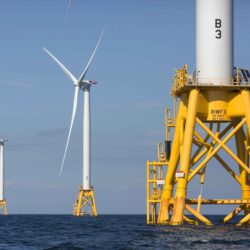
Transformative Greenway Expansion will bring 40+ more miles of biking infrastructure to city
Pedestrian and cyclist safety are priorities, economic development opportunities created
Expanding current level of more than half a million bike trips daily
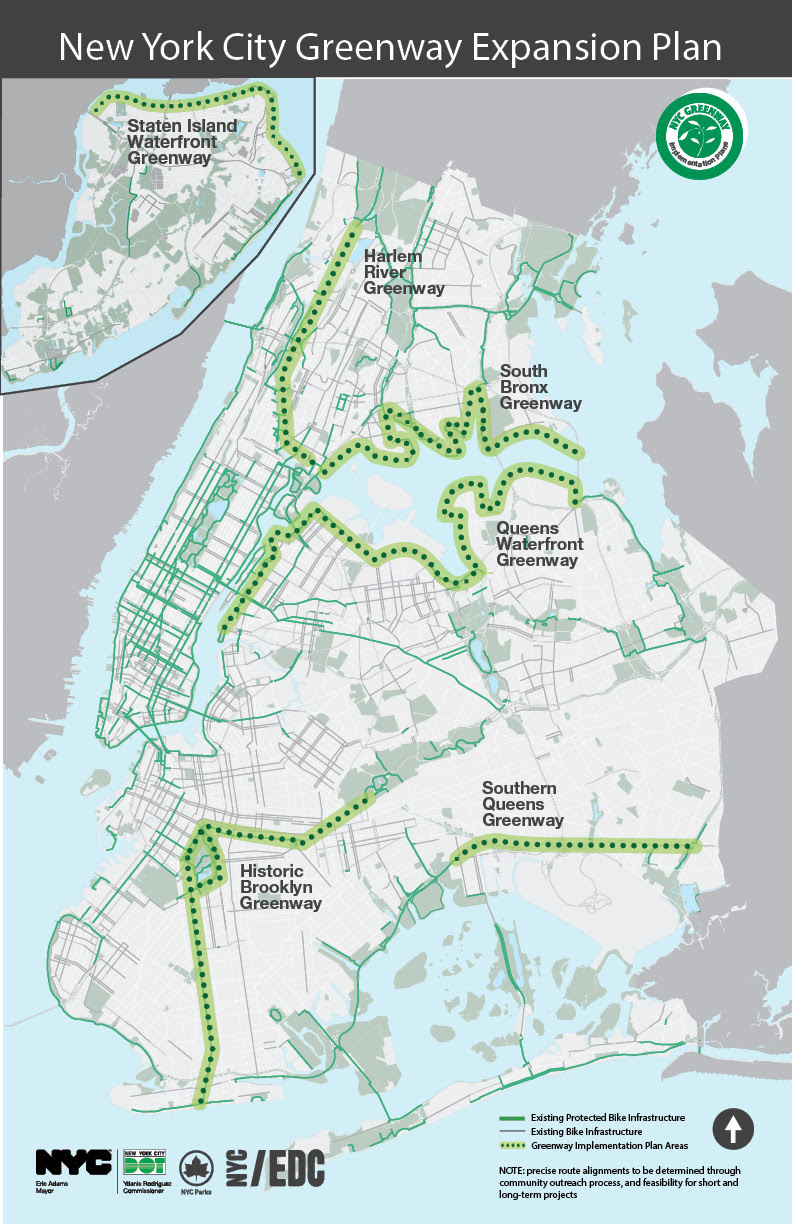
Image: New York City Department of Transportation
 BROOKLYN — With cycling numbers at an all-time high throughout the city, and more than 550,000 trips, the Mayor and appropriate department heads have expanded bike greenways by more than 40 miles in the outer boroughs. Economic development benefits will accrue.
BROOKLYN — With cycling numbers at an all-time high throughout the city, and more than 550,000 trips, the Mayor and appropriate department heads have expanded bike greenways by more than 40 miles in the outer boroughs. Economic development benefits will accrue.
Mayor Eric Adams has been joined by NYC Department of Transportation (DOT) Commissioner Ydanis Rodriguez and NYC Parks & Recreation Commissioner Sue Donoghue, and NYC Economic Development Head Andrew Kimball to launch a historic expansion of New York City’s greenways — filling gaps in the outer-borough greenway network to create 60 miles of greenway corridors. Through this expansion, the Adams administration will build more than 40 miles of new protected bike infrastructure and explore improvements to existing infrastructure along the corridors to expand safer, greener transportation options to Queens, Staten Island, Brooklyn, and the Bronx.
“When our administration came into office, we promised New Yorkers a five-borough administration — and we are taking a 40-mile step to deliver on that promise again today,” said Mayor Adams. “This historic expansion of our city’s greenways in Queens, Brooklyn, the Bronx, and Staten Island will transform the ways New Yorkers live, work, and get around. And with more New Yorkers biking than ever, it will connect every corner of our city with this safer, greener mode of transportation.”
“Our greenways provide both scenic recreational paths and important commuter routes connecting New Yorkers to jobs,” said DOT Commissioner Rodriguez. “With a focus on equity, we’re designing 60 miles of greenway corridors, identifying routes alongside communities that will better connect our existing network and improve the health and well-being of New Yorkers in historically underserved areas of the city. This is just one way we are working to make safe, sustainable, and environmentally friendly transportation options attractive to more New Yorkers.”
“Our greenways provide safe, active spaces for New Yorkers to explore the city, commute to work, reconnect with the great outdoors, and get exercise — without the distraction of car traffic,” said NYC Parks Commissioner Donoghue. “This historic expansion will fill important gaps in our citywide greenway network in the outer boroughs, which were previously overlooked, providing access to these vital green spaces for more New Yorkers than ever before. From the Staten Island waterfront to Throgs Neck and Soundview, New York City is about to get greener, cleaner, and healthier.”
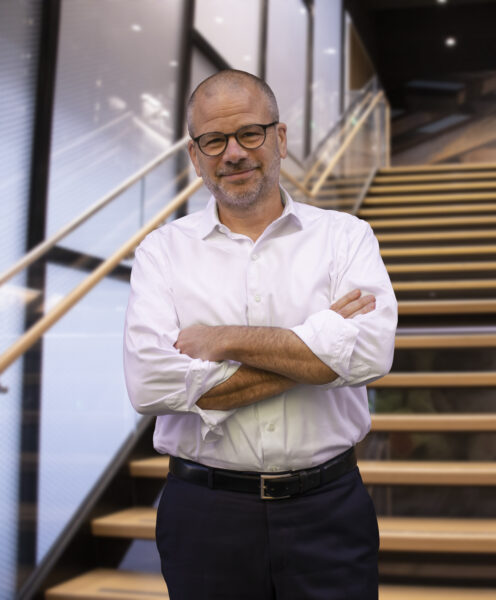
Photo: NYCEDC
“All New Yorkers should have access to greenways and enjoy the enormous benefits they bring to communities,” said NYCEDC President and CEO Kimball. “By identifying and expanding our greenway network in an equitable way, we will bring much-needed upgrades to our transportation and open space networks in traditionally underserved areas while also improving the work commutes that many New Yorkers use via greenways. We are thrilled to be partnering with DOT and NYC Parks on this important work that will have a lasting impact for generations to come.”
“Greenways are critical infrastructure for New Yorkers who use them to commute to work, connect to other neighborhoods, and visit parks and public spaces,” said Chief Public Realm Officer Ya-Ting Liu. “This expansion in New York City’s greenway network reflects the Adams administration’s commitment to equitable expansion of public spaces, and it will allow New Yorkers in all five boroughs to enjoy new transportation options and connect to other neighborhoods and public spaces safely.”
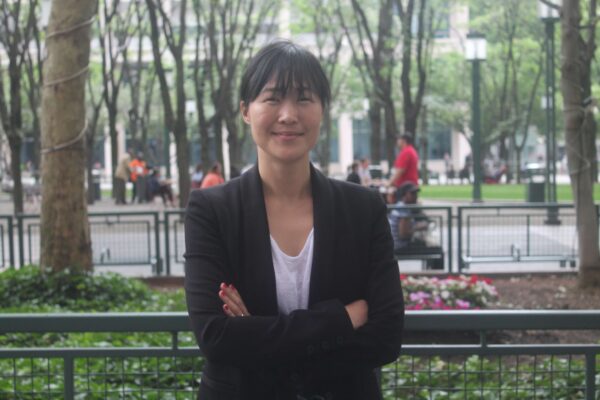
Photo: Jaime DeJesus/Brooklyn Eagle
The five corridors together represent roughly 60 miles of new and existing greenways, and they will build upon ongoing planning for a seven-mile Harlem River Greenway in the Bronx. The development of each of these five additional greenway plans is supported by a competitive $7.25 million federal RAISE grant, won by the Adams administration in August 2022.
This major expansion of the existing greenway network will begin with a collaborative, community-driven process to develop implementation plans for each corridor consisting of short- and long-term projects. These projects, and the overall effort, will fill critical gaps in the city’s greenway network, expand active transportation and green space, enhance cycling and pedestrian safety, and improve New Yorkers’ access to good jobs.
The identified corridors — chosen based on the merits of equity, park access, transportation utility, and economic development, among other factors — are:
Queens Waterfront, Gantry Plaza State Park to Little Bay Park (16 miles): This corridor will close gaps in cycling routes from Long Island City and Astoria to East Elmhurst and College Point, Queens. Running parallel to the Long Island Sound, this route will improve transportation options throughout New York City’s most diverse borough and enhance park access for Queens neighborhoods with limited green space. Connecting these neighborhoods with an active transportation network will particularly benefit Queens residents living within much of the planning area who are underserved by public transit access.
Historic Brooklyn, Coney Island to Highland Park (12 miles): This planning process will explore new connections to the United States’ oldest bike lanes on Ocean and Eastern Parkways, addressing gaps in the greenway network running from the southern tip of Brooklyn at Coney Island to the border of Brooklyn and Queens. The route will connect to Broadway Junction, giving commuters at one of Brooklyn’s busiest transit hubs new safe cycling access to some of the largest green spaces in the borough and complementing a nearly $500 million city-state investment in Broadway Junction, covering public realm improvements, station complex improvements, and accessibility upgrades. The implementation plan will also establish new design and maintenance standards for these historic greenway routes.
Staten Island Waterfront, Goethals Bridge to Verrazzano Bridge (10 miles): This greenway will provide a safe east-west cycling and walking route across the entire North Shore of Staten Island. It will provide major connections to forthcoming NYCEDC projects identified in Mayor Adams’ Staten Island North Shore Action Plan, including the Tompkinsville Esplanade and New Stapleton Waterfront, as well as existing destinations like the St. George Ferry Terminal, Goethals Bridge, and East Shore beachfront.

Photo courtesy of Brooklyn Greenway Initiative
South Bronx, Randall’s Island Park to SUNY Maritime (15 miles): Due to decades of disinvestment, Bronxites have long lacked the kind of waterfront access that New Yorkers in other parts of the city enjoy. From Randall’s Island eastward, the greenway will simplify and improve safety for commutes to industrial job centers like Hunts Point, as identified in Mayor Adams’ “Hunts Point Forward” vision plan and improve the connections between waterfront parks in the Soundview and Throgs Neck neighborhoods.
Southern Queens, Spring Creek Park to Brookville Park (seven miles): The Southern Queens Greenway will transform access to John F. Kennedy International Airport (JFK), complementing ongoing work by the Port Authority of New York and New Jersey. The roughly 35,000 people who work at JFK will have access to a fast, environmentally friendly mode of transportation connecting the airport to the remainder of the borough. This corridor — located in an area with limited cycling infrastructure — will also directly connect to the existing Jamaica Bay Greenway and parks in Southeast Queens, providing an important bike network expansion in the area.
DOT, NYC Parks, and NYCEDC will work collaboratively to develop implementation plans for each corridor, with planning processes staggered over the coming several years. DOT will work to identify and implement short-term projects along the identified routes while developing plans for long-term projects. Short-term projects will include the installation of markings, signs, and limited concrete work on city streets, while subsequent long-term projects will include more complex improvements to be constructed with future capital funds.
Work has already begun to develop the Harlem River Greenway in the Bronx — the city has hosted multiple workshops and pop-up engagement events this year. Planning will begin on the Queens Waterfront Greenway in early 2024. Over the next two years, the city will kick off new implementation plans for other corridors roughly every six months.
While DOT will pursue short-term greenway projects with in-house resources, the implementation plans will serve as roadmaps for the city to define capital projects and identify additional funding opportunities. DOT has used similar implementation plans to initiate capital projects for the Manhattan Waterfront, Brooklyn Waterfront, and Jamaica Bay Greenways.
“This expansion will help to protect bikers and pedestrians alike, allowing for easier, greener transportation for New Yorkers,” said New York State Assemblymember Robert Carroll. “I am happy to see this kind of work being focused on in my district and across the city.”
“I applaud Mayor Adams on building out a historic, world-class greenway network that will allow all New Yorkers to have access to beautiful green space,” said New York State Assemblymember Jenifer Rajkumar. “Greenways offer a safe path to walk and bike, reduce commute times, and strengthen our economy by connecting New Yorkers to jobs. The mayor’s vision of creating more than 40 miles of greenways in the outer boroughs will allow underserved, lower-income communities to connect with affordable transportation and job opportunities. Today’s comprehensive greenway plan will fill critical gaps in the city’s greenway network and improve cyclist safety at a time when cycling is at an all-time high. This is a win for my district and for the entire city.”
“In the bustling city, a new vision is born,” said New York State Senator Robert Jackson. “I commend the Department of Transportation, Parks, Economic Development Corporation, and the mayor’s administration for sowing the seeds of a healthier, greener future. The historic 60-mile corridor expansion isn’t just about bike lanes; it’s a pathway to a greener, safer, and more sustainable future for our boroughs and communities — a roadmap to a cleaner tomorrow.”
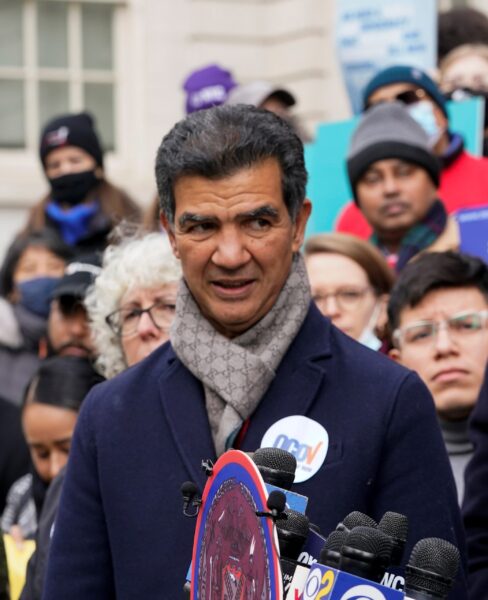
Photo: Mary Altaffer/AP
“The expansion of the Greenway will give New Yorkers an opportunity to increase their access to outdoor spaces and activities,” said New York State Senator Jose Serrano, Jr. “The 40 miles of newly added protected bike lanes will also provide a much-needed environmentally friendly and safe alternative for transportation throughout the city. Many thanks to Mayor Adams, DOT Commissioner Rodriguez, Parks Commissioner Donoghue, and EDC President and CEO Kimball for their work on this issue.”
“The expansion of our greenway corridors is an investment in the future of our city, green transportation options, and interborough travel,” said Bronx Borough President Vanessa L. Gibson. “Thank you to Mayor Eric Adams, DOT Commissioner Ydanis Rodriguez, NYC Parks Commissioner Sue Donoghue, and NYCEDC President and CEO Andrew Kimball for their collective work on this project and for ensuring the outer boroughs are prioritized.”
“Bike lanes and green spaces are how we enhance transit safety and our city as a whole,” said New York City Councilmember Amanda Farías. “These new 60 miles of protected street infrastructure and corridors will reduce carbon emissions, ensure bike safety for workers and families alike, and so much more. As Chair of the Committee on Economic Development, I am excited to see this announcement as these infrastructure upgrades are the exact kind of investments our local economies and workers need to thrive. Thank you, Mayor Adams, for your initiative on this matter, and I look forward to our continued partnership.”
“As the councilmember of the 40th district, I’m thrilled to announce that our city is taking a significant step towards a more sustainable and connected future,” said New York City Councilmember Rita Joseph. “By developing five new greenway corridors in the outer boroughs and filling critical gaps in our existing network, we’re creating over 40 miles of new protected bike infrastructure. This paves the way for 60 miles of new corridors that will not only enhance active transportation options but also expand green spaces, boost pedestrian and cyclist safety, and open doors to economic development opportunities. The surge in cycling with more than 550,000 daily bike trips and record-breaking bike-share ridership reflects our city’s commitment to a healthier and more vibrant New York.”
“Greenways provide safe spaces for recreation, exercise, and commuting which improve health, wellbeing, and quality of life,” said New York City Councilmember Carlina Rivera. “Historically, low-income neighborhoods and communities of color, particularly in the outer boroughs, have seen the least investment in greenway infrastructure. I commend the administration for their ongoing commitment to making important investments in underserved communities and expanding the citywide greenway network. I’m proud to have passed legislation in the City Council that supports moving us away from a fragmented greenway system toward a more cohesive network, and I look forward to continued work with the administration to expand recreational space.”
“An additional 40 miles of new greenways in five outer borough corridors will at once mean less cars on the road polluting our air and more dollars in the pockets of local businesses,” said Pat McClellan, policy director, New York League of Conservation Voters. “NYLCV commends Mayor Adams and DOT Commissioner Rodriguez for this new greenway expansion and for their ongoing commitment to creating greener, safer, and more sustainable transportation options for our communities.”
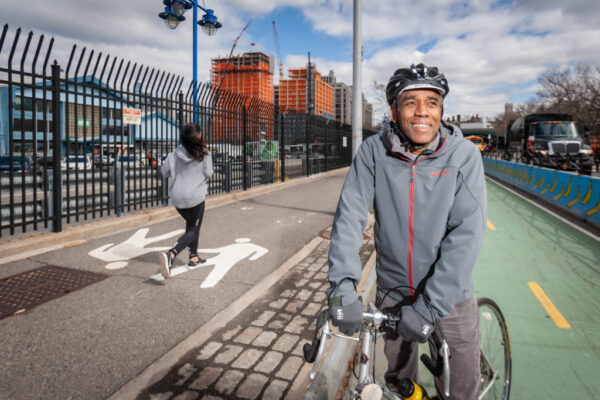
Photo: Ari Mintz
“We applaud Mayor Adams and his administration for developing over 40 miles of new greenway corridors in the outer boroughs where they’re desperately needed,” said Ken Podziba, president and CEO, Bike New York. “Protected and connected bike infrastructure is essential to enabling more New Yorkers to experience bicycling, which connects communities, encourages healthy exercise, and provides emission-free fun. This improvement is another step in the right direction as DOT continues to reimagine our public spaces; it’s no wonder cycling in the city has reached an all-time high.”
Rob Freudenberg, Vice President of Energy and Environment at Regional Plan Association, stated, “RPA is proud to support the expansion of the greenway network throughout the city, which builds on many of the principles included in RPA’s Five Borough Bikeway report. Greenways provide New Yorkers with healthy and low-carbon ways of transportation that make the city safer and more sustainable. Of particular importance are high-capacity, protected bike lanes which make biking more accessible and equitable to people of all races, incomes and backgrounds. RPA is thrilled to continue to partner on this work, and we would like to offer our congratulations to Mayor Adams and his administration on this announcement.”
“As an advocate and steward for the Brooklyn greenway system for two decades and a founder of the NYC Greenways Coalition, Brooklyn Greenway Initiative is delighted to see this major investment in Brooklyn greenways as well as in four other corridors across New York City,” said Hunter Armstrong, executive director, Brooklyn Greenway Initiative, and member, NYC Greenways Coalition. “This expansion will fill in gaps in the greenway network including many underserved communities and will provide millions more New Yorkers with safe commuting and recreational options by foot and by bike. We look forward to working with Mayor Adams, city agencies, greenway partners, and current and future greenway users across the city to ensure an equitable, safe, well-designed, and well-maintained greenway network. Cycling, walking and running are the cleanest, greenest, and healthiest ways to get around New York City. Cycling has reached an all-time high in New York City, and major infrastructure investments like this greenway expansion are critical to keep up this positive trend.”
“The Harlem River Working Group (HRWG) celebrates the announcement of Mayor Adams and NYC DOT Commissioner Rodriguez about the expansion of the Citywide Greenway Network to more communities across the five boroughs,” said Chauncy Young, coordinator, Harlem River Working Group. “Access to Greenways and safe places to recreate is a racial and environmental justice issue. We are proud of the city and the NYC Delegation in obtaining the RAISE Grant Funding and ensuring it goes to communities with the highest needs and the HRWG is proud to be a member of the NYC Greenway Coalition.”
“RPA is proud to support the expansion of the greenway network throughout the city, which builds on many of the principles included in RPA’s Five Borough Bikeway report,” said Rob Freudenberg, vice president, energy and environment, Regional Plan Association. “Greenways provide New Yorkers with healthy and low-carbon ways of transportation that make the city safer and more sustainable. Of particular importance are high-capacity, protected bike lanes which make biking more accessible and equitable to people of all races, incomes and backgrounds. RPA is thrilled to continue to partner on this work, and we would like to offer our congratulations to Mayor Adams and his administration on this announcement.”
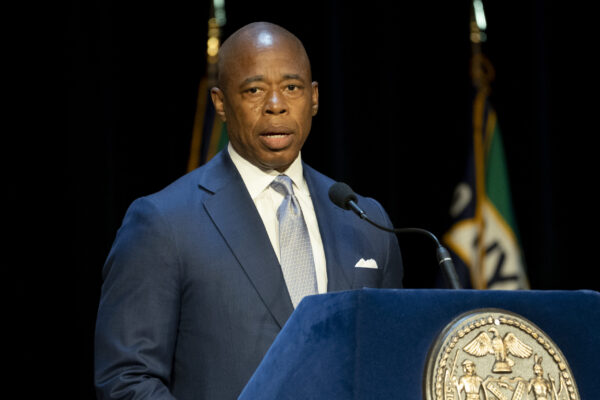
Photo: John Minchillo/AP
“New Yorkers need a safe and connected greenway network,” said Danny Harris, executive director, Transportation Alternatives. “We’re glad to see the City of New York announce a historic expansion of our greenway network in the outer boroughs that includes 40 miles of new protected places to bike. As more New Yorkers choose to bike, expanding our greenways is key to building on this momentum.”
“Every New Yorker deserves access to safe transportation options and this greenway expansion will help deliver that access to parts of the city that sorely need it,” said Carl Mahaney, director, Streetopia Upper West Side. “Biking is booming — and yet women, non-white New Yorkers, and older riders still feel reluctant to participate on unpredictable or unsafe infrastructure. Connecting greenways and expanding safe lanes across the city will create equity and reliability, ensuring everyone has the opportunity to ride safely and confidently.”
“It’s exciting that the next phase of expansion of New York City’s greenway network is now official,” said Eric McClure, executive director and treasurer, StreetsPAC. “Greenways serve so many important functions, as critical connectors in the city’s transportation network, as green spaces in which New Yorkers can recreate and experience nature, as pathways to economic opportunity, and as bulwarks in environmental resiliency. We congratulate our partners in the NYC Greenways Coalition for the success of our collective advocacy and thank the administration for this important step toward realizing a robust greenway network that will serve all New Yorkers.”
“This historic investment in greenway planning is an important step in transforming how New Yorkers get around, which right now is far too difficult in the Bronx,” said Siddharth Motwani, greenway coordinator, Bronx River Alliance. “The enhanced focus on a greenway network that will improve the way we move around the Bronx and the city is sorely needed, to provide safer streets and connections for everyone, promote health and active living, and redress historic disinvestment in communities who need better access to jobs, schools, and other activities.”
“In a dense city like New York, where urban heat islands disproportionately threaten environmental justice communities, and where the majority of households citywide don’t own a car, greenways are really a slam-dunk piece of infrastructure,” said Corey Hannigan, active transportation program manager, Tri-State Transportation Campaign. “In contrast to the rising epidemic of fatal crashes on our streets, greenways provide a safe, affordable, and environmentally sustainable alternative for New Yorkers to move about their communities, engage socially, and recover mentally. What other type of project simultaneously gives residents both a new park and a safer transportation route for children and seniors? Greenways are also an increasingly essential piece of resiliency infrastructure as our region adapts to the worsening effects of climate change. More than just a respite from our harsh urban surroundings, they encourage low-carbon mobility options (like walking and biking), sequester carbon into organic plant life, restore habitats for species devastated by climate change, cool communities by expanding shade-tree coverage, and absorb stormwater like a giant sponge. What’s not to love?”
Leave a Comment
Related Articles

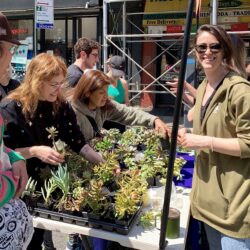
Earth Day weekend 2024 celebrated in Brooklyn

Healthy harbor update: Billion Oyster Project hosts informative fundraiser in exclusive Williamsburg setting

Premium Content
The key to a healthy harbor:
Support of Billion Oyster Project,
and their education program, will
restore city’s harbor, vital shoreline
Leave a Comment
The Brooklyn Daily Eagle and brooklyneagle.com cover Brooklyn 24/7 online and five days a week in print with the motto, “All Brooklyn All the Time.” With a history dating back to 1841, the Eagle is New York City’s only daily devoted exclusively to Brooklyn.
© 2024 Everything Brooklyn Media
https://brooklyneagle.com/articles/2023/10/12/transformative-greenway-expansion-will-bring-40-more-miles-of-biking-infrastructure-to-city/
